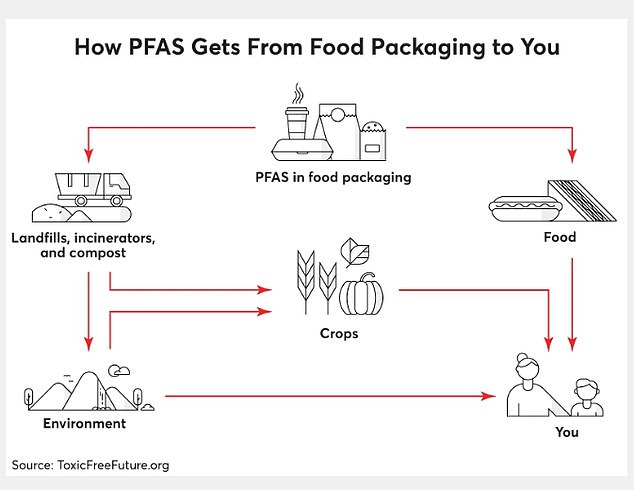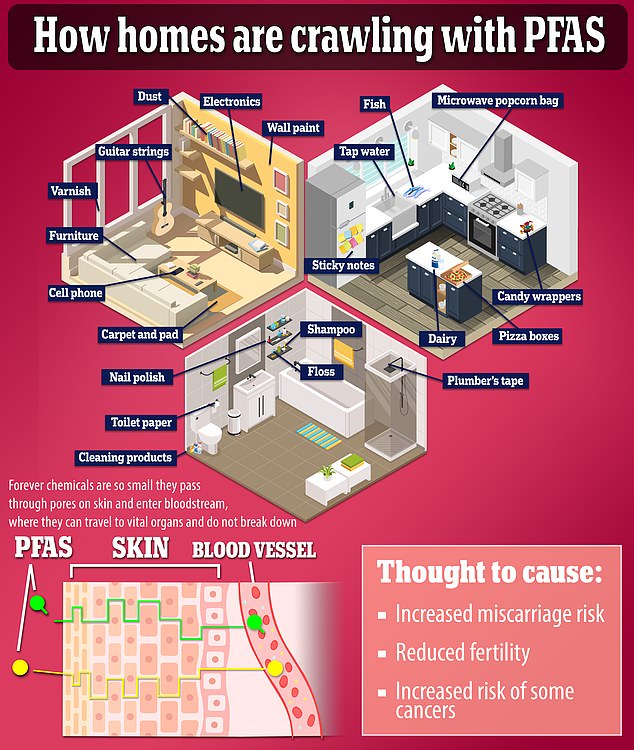Graphic reveals the ‘forever chemicals’ lurking in everyday foods linked to cancer and infertility
A shock study last week found that lobster, shrimp and sushi lovers are at high risk of ‘forever chemical’ poisoning.
The researchers behind the study warned that seafood may be an underestimated source of the toxins, which have been strongly linked to cancer.
But a graph from DailyMail.com shows how the ubiquitous chemicals lurk in virtually every food group, including those that bill themselves as healthy.
There is no safe exposure to forever chemicals and they have been linked to multiple cancers, asthma, fertility problems, obesity, birth defects, diabetes and autism
The graphic is based on results from tests by watchdogs, which analyzed the levels of PFAS and other forever chemicals in grocery products.
The product with the highest amount of phthalates – a type of perennial chemical used to make plastics – was Annie’s canned organic cheese ravioli, which contained 53,580 nanograms of phthalates per serving.
Phthalates can be found in the linings of canned goods and plastic containers and can leach into the food itself.
They are known as endocrine disruptors and have been linked to breast cancer, reproductive and developmental problems, cardiac and respiratory complications, and neurological and behavioral problems.
Consumers who want to avoid the chemicals should look for “BPA-free” on product labels.
Other products with the highest levels included Del Monte’s canned peaches (25,000), Chicken of the Sea’s canned pink salmon (24,320); and Fairlife’s protein milk, which comes in a plastic bottle (20,450).
As with Annie’s canned ravioli, these products are likely high in phthalates because they are packaged in cans or plastic material.
High levels were found in products from all food groups and drinks – with no category such as dairy or meat – more likely to contain chemicals than another.
Poland Spring water in plastic bottles contained 4,200 nanograms of phthalates per serving. Yoplait low-fat yogurt in a plastic container contained nearly 11,000 nanograms of the forever chemical.
Heart-healthy Cheerios in a plastic bag inside a cardboard box also contain about 11,000 nanograms.
Even baby food was not immune to the toxins. Gerber food in a glass jar and Similac baby food in a can both contain approximately 4,200 nanograms of phthalates per serving.
Forever chemicals aren’t just in store-bought food products; another category of forever substances, PFAS, was found in unsafe levels in food containers.
PFAS, per- and polyfluoroalkyl substances, are microscopic substances that take thousands of years to break down in the environment or the human body.
They are found in textiles, firefighting foam, nonstick cookware, clothing and grease-resistant food packaging, where they can seep into food.

The above graph from Toxic Free Future shows how toxic PFAS chemicals end up in food products

There is no level of safe exposure to the chemicals and PFAS have been linked to multiple cancers, asthma, fertility problems, obesity, birth defects, diabetes and autism.
When ingested through food, it is not clear how many of the chemicals are broken down by the body or released naturally during the digestive process. But the CDC says between 2 and 20 nanograms per milliliter of blood can cause adverse health problems.
A separate CR report examining the presence of these tested 118 fast food packages and containers for their total organic fluorine content, which is considered the simplest way to assess the total PFAS content of a material.
Sixty-three items had detectable levels of organic fluorine and 22 of those had 100 or more parts per million and 15 had 20 or more ppm.
A 2023 policy in California now requires paper food packaging to contain less than 100 ppm organic fluoride.
CR experts support a limit of 20 ppm.
The most contaminated packaging was Nathan’s Famous green bag at 876 ppm. That was followed by Nathan’s Famous red bag for sides (618 ppm); the wrapper for Chick-fil-A’s sandwich wrap (553.5 ppm); Cava’s fiber container for children’s meals (548); and Cava’s fiber bowl (508.3 ppm).
Although PFAS appears to be ubiquitous, there are ways you can reduce your exposure, such as not reheating food in its original packaging, transferring takeout food from its original packaging and storing it in glass or silicone containers, and choosing companies who have pledged to reduce the use of PFAS. PFAS in their products.
Additional testing done by the Natural Resources Defense Council on apparel, footwear and accessories gave 14 companies F grades regarding their use of PFAS in their products
The NRDC asked companies a series of questions regarding PFAS and their clothing items, including whether they had policies restricting or banning the use of PFAS, or plans to remove the chemicals from their products.
Based on their answers, brands received a grade from the NRDC.
Those receiving failing grades included REI, Columbia Sportswear, Macy’s, Walmart, Nordstrom, Kate Spade, Under Armour, Skechers and Michael Kors.
And ToxicFreeFuture.org found it PFAS in pillow protectors from Amazon, mattress protectors from Costco, stain-resistant bedding from Macy’s and a sheet set from Target.
The test results may paint a grim picture of the chemicals Americans consume every day, but CR said levels of some substances were lower than when it tested similar products in 2009.
It “suggests that we are at least moving in the right direction when it comes to bisphenols,” says Dr. James Rogers, who oversees product safety testing at Consumer Reports.
